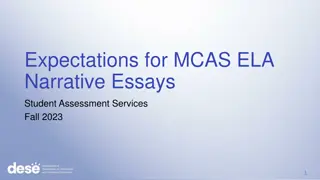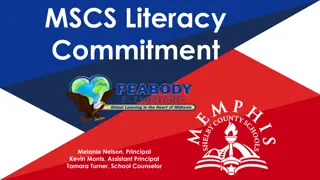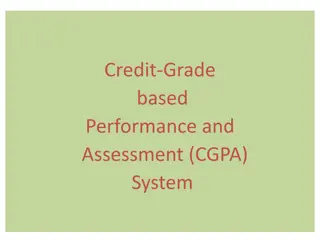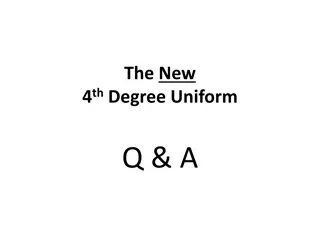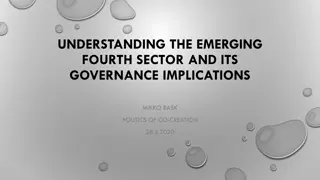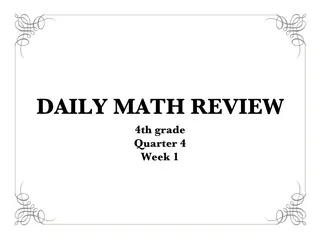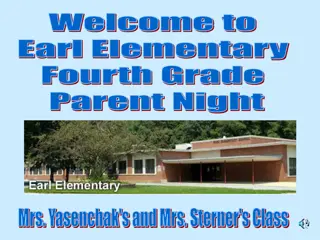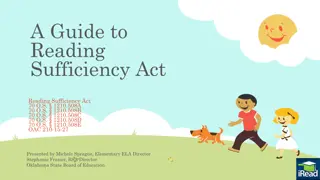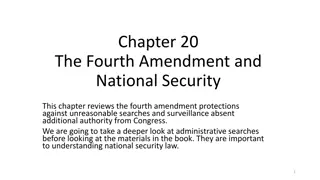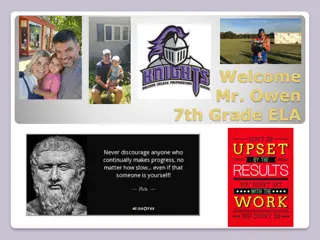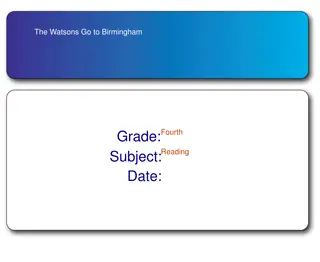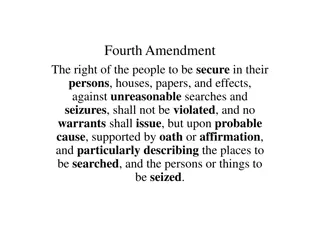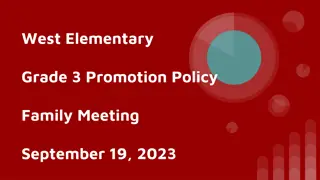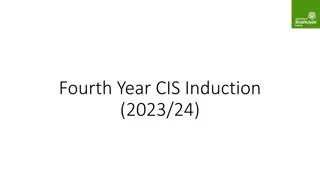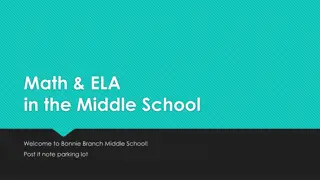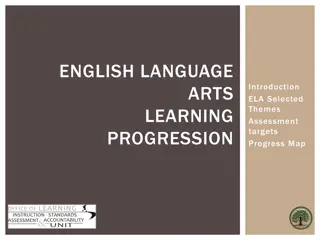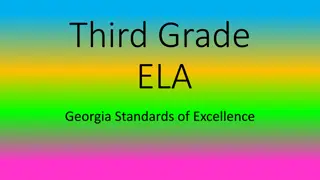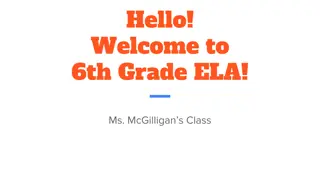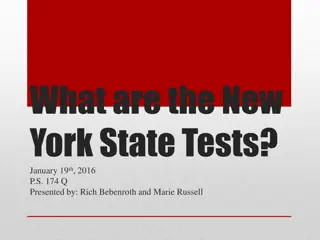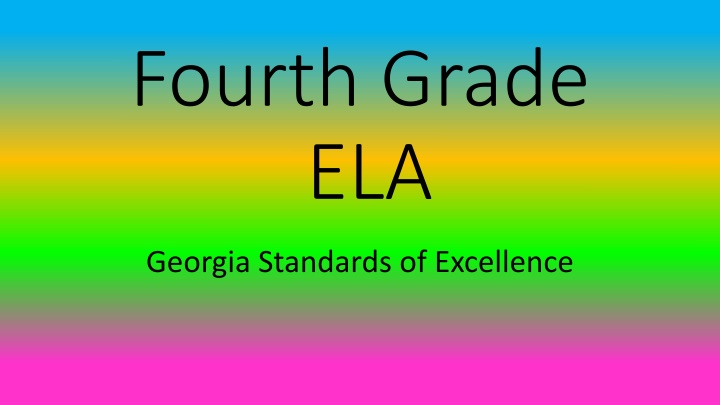
Enhancing Fourth Grade ELA Skills with Georgia Standards of Excellence
Explore key ELA standards for fourth graders in Georgia, including analyzing text details, determining themes, describing characters and events, understanding literary structure, interpreting words and phrases, and integrating knowledge.
Download Presentation

Please find below an Image/Link to download the presentation.
The content on the website is provided AS IS for your information and personal use only. It may not be sold, licensed, or shared on other websites without obtaining consent from the author. If you encounter any issues during the download, it is possible that the publisher has removed the file from their server.
You are allowed to download the files provided on this website for personal or commercial use, subject to the condition that they are used lawfully. All files are the property of their respective owners.
The content on the website is provided AS IS for your information and personal use only. It may not be sold, licensed, or shared on other websites without obtaining consent from the author.
E N D
Presentation Transcript
Fourth Grade ELA Georgia Standards of Excellence
Reading Literary Reading Literary Key Ideas and Details
ELAGSE4RL1 ELAGSE4RL1 Refer to details and examples in a text when explaining what the text says explicitly and when drawing inferences from the text.
ELAGSE4RL2 ELAGSE4RL2 Determine a theme of a story, drama, or poem from details in the text; summarize the text.
ELAGSE4RL3 ELAGSE4RL3 Describe in depth a character, setting, or event in a story or drama, drawing on specific details in the text (e.g., a character s thoughts, words, or actions).
Reading Literary Reading Literary Craft and Structure
ELAGSE4RL4 ELAGSE4RL4 Determine the meaning of words and phrases as they are used in a text, including those that allude to significant characters found in mythology (e.g., Herculean).
ELAGSE4RL5 ELAGSE4RL5 Explain major differences between poems, drama, and prose, and refer to the structural elements of poems (e.g., verse, rhythm, meter) and drama (e.g., casts of characters, settings, descriptions, dialogue, stage directions) when writing or speaking about a text.
ELAGSE4RL6 ELAGSE4RL6 Compare and contrast the point of view from which different stories are narrated, including the difference between first- and third-person narrations.
Reading Literary Reading Literary Integration of Knowledge and Ideas
ELAGSE4RL7 ELAGSE4RL7 Make connections between the text of a story or drama and a visual or oral presentation of the text identifying similarities and differences.
ELAGSE4RL9 ELAGSE4RL9 Compare and contrast the treatment of similar themes and topics (e.g., opposition of good and evil) and patterns of events (e.g., the quest) in stories, myths, and traditional literature from different cultures.
Reading Literary Reading Literary Range of Reading and Level of Text Complexity
ELAGSE4RL10 ELAGSE4RL10 By the end of the year, read and comprehend literature, including stories, dramas, and poetry, in the grades 4-5 text complexity band proficiently, with scaffolding as needed at the high end of the range.
Reading Reading Informational Informational Key Ideas and Details
ELAGSE4RI1 ELAGSE4RI1 Refer to details and examples in a text when explaining what the text says explicitly and when drawing inferences from the text.
ELAGSE4RI2 ELAGSE4RI2 Determine the main idea of a text and explain how it is supported by key details; summarize the text.
ELAGSE4RI3 ELAGSE4RI3 Explain events, procedures, ideas, or concepts in a historical, scientific, or technical text, including what happened and why, based on specific information in the text.
Reading Reading Informational Informational Craft and Structure
ELAGSE4RI4 ELAGSE4RI4 Determine the meaning of general academic language and domain specific words or phrases in a text relevant to a grade 4 topic or subject area.
ELAGSE4RI5 ELAGSE4RI5 Describe the overall structure (e.g., chronology, comparison, cause/effect, problem/solution) of events, ideas, concepts, or information in a text or part of a text.
ELAGSE4RI6 ELAGSE4RI6 Compare and contrast a firsthand and secondhand account of the same event or topic; describe the differences in focus and the information provided
Reading Reading Informational Informational Integration of Knowledge and Ideas
ELAGSE4RI7 ELAGSE4RI7 Interpret information presented visually, orally, or quantitatively (e.g., in charts, graphs, diagrams, time lines, animations, or interactive elements on Web pages) and explain how the information contributes to an understanding of the text in which it appears.
ELAGSE4RI8 ELAGSE4RI8 Explain how an author uses reasons and evidence to support particular points in a text.
ELAGSE4RI9 ELAGSE4RI9 Integrate information from two texts on the same topic in order to write or speak about the subject knowledgeably.
Reading Reading Informational Informational Range of Reading and Level of Text Complexity
ELAGSE4RI10 ELAGSE4RI10 By the end of the year, read and comprehend informational texts, including history/social studies, science, and technical texts, in the grades 4-5 text complexity band proficiently, with scaffolding as needed at the high end of the range.
Reading Reading Foundation Foundation Phonics and Word Recognition
ELAGSE4RF3 ELAGSE4RF3 Know and apply grade-level phonics and word analysis skills in decoding words. a) Use combined knowledge of all letter- sound correspondences, syllabication patterns, and morphology (e.g., roots and affixes) to read accurately unfamiliar multi-syllabic words in context and out of context.
Reading Reading Foundation Foundation Fluency
ELAGSE4RF4 ELAGSE4RF4 Read with sufficient accuracy and fluency to support comprehension. a) Read on-level text with purpose and understanding. b) Read on-level prose and poetry orally with accuracy, appropriate rate, and expression on successive readings. c) Use context to confirm or self-correct word recognition and understanding, rereading as necessary.
Writing Writing Text Types and Purpose
ELAGSE4W1 ELAGSE4W1 Write opinion pieces on topics or texts, supporting a point of view with reasons. a) Introduce a topic or text clearly, state an opinion, and create an organizational structure in which related ideas are grouped to support the writer s purpose. b) Provide reasons that are supported by facts and details. c) Link opinion and reasons using words and phrases (e.g., for instance, in order to, in addition). d) Provide a concluding statement or section related to the opinion presented.
ELAGSE4W2 ELAGSE4W2 Write informative/explanatory texts to examine a topic and convey ideas and information clearly. Introduce a topic clearly and group related information in paragraphs and sections; include formatting (e.g., headings), illustrations, and multimedia when useful to aiding comprehension. b) Develop the topic with facts, definitions, concrete details, quotations, or other information and examples related to the topic. c) Link ideas within categories of information using words and phrases. (e.g., another, for example, also, because). a) d) Use precise language and domain-specific vocabulary to inform about or explain the topic. e) Provide a concluding statement or section related to the information or explanation presented.
ELAGSE4W3 ELAGSE4W3 Write narratives to develop real or imagined experiences or events using effective technique, descriptive details, and clear event sequences. a) Orient the reader by establishing a situation and introducing a narrator and/or characters; organize an event sequence that unfolds naturally. b) Use dialogue and description to develop experiences and events or show the responses of characters to situations. c) Use a variety of transitional words and phrases to manage the sequence of events. d) Use concrete words and phrases and sensory details to convey experiences and events precisely. e) Provide a conclusion that follows from the narrated experiences or events.
Writing Writing Production and Distribution of Writing
ELAGSE4W4 ELAGSE4W4 Produce clear and coherent writing in which the development and organization are appropriate to task, purpose, and audience. (Grade specific expectations for writing types are defined in Standards 1 3 above.)
ELAGSE4W5 ELAGSE4W5 With guidance and support from peers and adults, develop and strengthen writing as needed by planning, revising, and editing. (Editing for conventions should demonstrate command of Language Standards 1 3 up to and including grade 4.)
ELAGSE4W6 ELAGSE4W6 With some guidance and support from adults, use technology, including the Internet, to produce and publish writing as well as to interact and collaborate with others; demonstrate sufficient command of keyboarding skills to type a minimum of one page in a single sitting.
Writing Writing Research to Build and Present Knowledge
ELAGSE4W7 ELAGSE4W7 Conduct short research projects that build knowledge through investigation of different aspects of a topic.
ELAGSE4W8 ELAGSE4W8 Recall relevant information from experiences or gather relevant information from print and digital sources; take notes and categorize information, and provide a list of sources.
ELAGSE4W9 ELAGSE4W9 Draw evidence from literary or informational texts to support analysis, reflection, and research. a) Apply grade 4 Reading Standards to literature (e.g., Describe in depth a character, setting, or event in a story or drama, drawing on specific details in the text [e.g., a character s thoughts, words, or actions] ). b) Apply grade 4 Reading Standards to informational texts (e.g., Explain how an author uses reasons and evidence to support particular points in a text ).
Writing Writing Range of Writing
ELAGSE4W10 ELAGSE4W10 Write routinely over extended time frames (time for research, reflection, and revision) and shorter time frames (a single sitting or a day or two) for a range of discipline-specific tasks, purposes, and audiences.
Speaking and Speaking and Listening Listening Comprehension and Collaboration
ELAGSE4SL1 ELAGSE4SL1 Engage effectively in a range of collaborative discussions (one-on-one, in groups, and teacher-led) with diverse partners on grade 4 topics and texts, building on others ideas and expressing their own clearly. a) Come to discussions prepared, having read or studied required material; explicitly draw on that preparation and other information known about the topic to explore ideas under discussion. b) Follow agreed-upon rules for discussions and carry out assigned roles. c) Pose and respond to specific questions to clarify or follow up on information, and make comments that contribute to the discussion and link to the remarks of others. d) Review the key ideas expressed and explain their own ideas and understanding in light of the discussion.
ELAGSE4SL2 ELAGSE4SL2 Paraphrase portions of a text read aloud or information presented in diverse media and formats, including visually, quantitatively, and orally.
ELAGSE4SL3 ELAGSE4SL3 Identify the reasons and evidence a speaker provides to support particular points.

